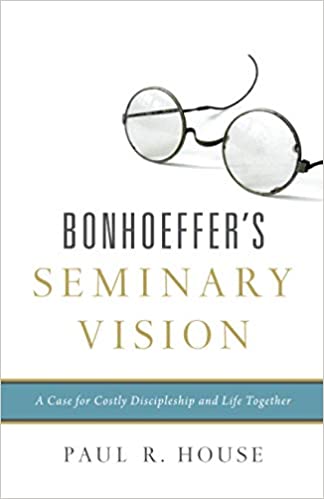A Brief Book Summary from Books at a Glance
by Mark Baker
About the Author
Paul House (PhD, The Southern Baptist Theological Seminary) is a pastor-theologian who has taught at Taylor University and Wheaton College as well as his current institution, Beeson Divinity School.
Overview of the Book
Most Christians are at least generally familiar with the life of Dietrich Bonhoeffer and his major works, The Cost of Discipleship and Life Together. What is less known is that Bonhoeffer wrote these two works with his seminary in mind. Because of the tumultuous political climate in which he ministered, Bonhoeffer’s tenure as seminary president was relatively brief, but his vision is one that we need to hear today.
Table of Contents
- Bonhoeffer’s Path to Seminary Ministry
- Bonhoeffer and His Seminaries
- Ministers for the Visible Body of Christ: The Seminary and The Cost of Discipleship
- A Visible Community of the Body of Christ: The Seminary and Life Together
- The Visible Faithful Witness: The Seminary and Perseverance
- Life Together Today: Some Possibilities for Incarnational Seminaries
Preface
There is an increasing trend in seminaries and Bible colleges to move away from in-person instruction in favor of hybrid and online models. These institutions want to survive, and going online is a “necessary evil,” they say. Even when classes are held in person, oftentimes professors, while generally approachable, do not seek out opportunities to spend time with students. Bonhoeffer’s vision for seminary was radically different from this approach. This book looks to Bonhoeffer “to try to discern his theology of seminary ministry and to consider if or how to apply his theology and practice to our current situation” (15).
Chapter 1: Bonhoeffer’s Path to Seminary Ministry
One scholar observes that in the context of seminary training, Bonhoeffer was “confrontational and demanding in ecclesiastical matters, radically biblical, and rigorous in matters of piety” (24). Bonhoeffer lived in an era where the church was beholden to the ideals of the state, and the ethics of the state were becoming increasingly upside down. Samuel Wells notes that “Bonhoeffer’s most radical step was to become an educator. In setting up the seminary at Finkenwalde, Bonhoeffer trained students … to learn to do what they could do for themselves” (25).
In short, the seminary existed for them to learn how to learn, which included the necessity of “reading” culture and knowing how to respond biblically and courageously. Bonhoeffer’s seminary ministry only occurred from 1935–1940, but he wrote The Cost of Discipleship and Life Together during that time (1937 and 1939, respectively). “These works were presented to and written about seminary students, seminary supporters, and seminary alumni. Thus, it is right to examine them with that context in mind for our current situation’s sake” (27). . . .
[To continue reading this summary, please see below....]The remainder of this article is premium content. Become a member to continue reading.
Already have an account? Sign In
